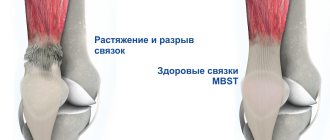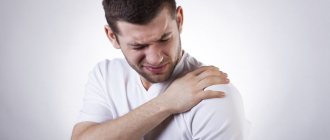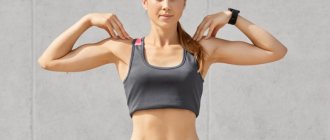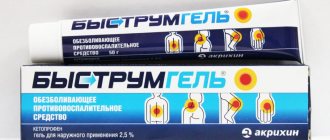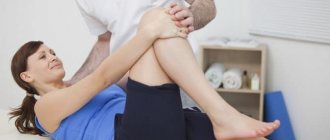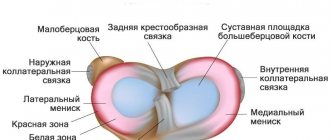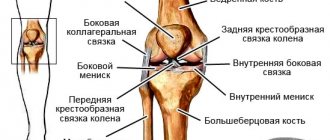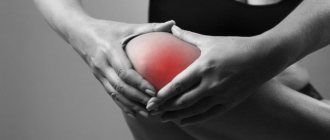Shoulder joint
– one of the most mobile joints in the human body. The structure of this joint makes it possible to carry out various movements of the upper limbs in a wide range: rotational, flexion, abduction, extension and adduction actions.
Features of the joint
The shoulder joint has a complex structure that provides a significant range of movements in 3 different planes. Increased strength and prevention of the head of the humerus from popping out is ensured by the presence of structures represented by connective tissue fibers. Since the shoulder performs a significant amount of work, it is often subject to injuries and pathological processes that are accompanied by rupture of ligaments, as well as a cartilaginous structure called the labrum (it also serves to stabilize the joint).
Rehabilitation after ligament and tendon rupture
Treatment and rehabilitation of ligament rupture
Regardless of where in the body a ligament rupture occurs, treatment is a challenge because ligamentous tissue is highly dense, difficult to heal, and slow to restore normal blood circulation and neural connections.
The simplest way to treat a ruptured (sprained) ligament is to apply a tight bandage made of an elastic bandage, keep the foot in ice and, preferably, on an elevation so that the blood drains from the lesion. If during the first three days the swelling does not go away and the joint does not regain its mobility, there is a possibility of a dislocation or fracture (diagnosed by x-ray), as well as a severe rupture of the ligament, which requires rigid fixation of the joint and professional surgical intervention.
Klinka "K+31" has trained surgeons and traumatologists, as well as a full range of diagnostic and therapeutic equipment and modern technologies for the treatment and rehabilitation of patients with any type of rupture of articular ligaments. When you contact us, we will provide:
- in-depth examination of injured tissues and making an accurate diagnosis;
- cryotherapy (cold compresses), installation of a splint or orthosis on the joint;
- injections of painkillers and drug treatment at the required level;
- pumping out accumulated fluid and blood in the joint capsule (puncture-puncture);
- prevention of arthritic complications in the joint;
In case of a complete rupture of the ligament, the clinic’s specialists perform surgical intervention - plastic surgery on the ligament (arthroscopic reconstruction) with the installation of a graft (autoplasty with the tendon’s own tissue, titanium or polymer fixation).
Rehabilitation after ligament rupture
The process of rehabilitation of a patient after a complex ligament rupture is a long process, which is very important for the complete restoration of elasticity and motor functionality of the damaged joint. At the K+31 clinic, rehabilitation is carried out first on an inpatient basis (first stage), then on an outpatient basis and outpatient basis (second and third stages).
The goal of rehabilitation is to restore muscles and tendons, full blood flow and functionality of nerve endings, and return tissues to their natural physical strength and reliability. The process is lengthy and is carried out at a gentle pace - this is especially important when rehabilitation is carried out for a ruptured cruciate ligament of the knee - one of the most severe types of joint injury.
The patient is prescribed a set of physiotherapeutic procedures, which includes:
- UHF therapy;
- ultrasonic irradiation (tissue micromassage);
- paraffin therapy (anti-inflammatory effect);
- diadynamic therapy (pain relief with currents of different frequencies);
- magnetic therapy (relieving swelling and improving blood circulation);
- therapeutic massage courses;
- treatment with therapeutic mud, water baths and a visit to the pool.
In addition, rehabilitation after cruciate ligament surgery involves developing an individual diet, taking vitamin complexes and nutritional supplements, and physical therapy.
Shoulder ligament rupture
Rupture of the ligaments of the shoulder joint The mechanism of violation of the integrity of the connective tissue components is a significant mechanical effect (excessive stretching), as well as a decrease in the strength and elasticity of the fibers. The implementation of pathogenesis is possible due to the influence of various reasons, the most common include:
- Shoulder injury, which is often the result of a fall on an outstretched arm, a bruise, or excessive and sudden extension. Traumatic changes are more common in active people.
- Excessive systematic loads on the shoulder in representatives of certain professions (painters, plasterers).
- Long-term inflammatory processes caused by infection, autoimmune process (rheumatoid pathology).
- Degenerative-dystrophic conditions associated with deterioration of nutrition of the structures of the musculoskeletal system.
- Congenital weakening of fibers, in which a common manifestation of pathology is habitual dislocation.
After a diagnosed pathological condition in which the ligaments of the shoulder joint are torn, treatment is prescribed by a specialist, taking into account the etiology.
Causes, symptoms and diagnostic features of shoulder ligament injuries
A bruise occurs when there is a direct impact on the joint, and damage to the ligamentous apparatus occurs under the influence of force that is applied at a distance from it. The mechanism of occurrence of these two types of injuries is essentially the same, but the significant difference is in the force that causes them. With dislocation it is much greater than with isolated damage to the ligamentous fibers.64
The main cause of rupture of the ligaments and muscles of the shoulder is movement, which is typical for this joint, but significantly exceeds the physiological amplitude. Damage to the ligamentous apparatus can also occur when performing movements unusual for the shoulder joint. But in both cases, the applied force, which causes partial or complete rupture of the elastic fibers, is insufficient to dislocate the shoulder.64
Most often, ligamentous injuries are diagnosed in people who play sports. Typically, a fall on a twisted or outstretched arm causes a rupture of the shoulder ligaments, and the symptom of such an injury is pain when moving. But it is difficult to determine which movements cause more discomfort.64
Diagnosis of injuries to the shoulder joint is difficult, especially if we are talking about hemorrhage into the joint cavity. This is due to the fact that it is surrounded by massive muscles, which make palpation difficult. A reliable diagnosis can be made by X-ray diagnostics, which helps exclude joint dislocation.64
Types
For the convenience of diagnostics and subsequent determination of treatment tactics, a classification of changes in the ligamentous apparatus of the shoulder was introduced into clinical practice. It involves dividing into types based on several criteria. According to the severity of changes, the following are distinguished:
- Complete rupture of a ligament, cartilaginous lip or tendon of one of the muscles.
- Partial rupture, in which the integrity of only individual fibers is broken.
Depending on the predominant localization, separate damage to one of the structures or a combination of them may develop. Also, the division of damage is based on the main causative factor, therefore traumatic and pathological ruptures are distinguished.
Preventing tendon injuries
The tendon bundles are protected from tears and overstrains by elastic fabric. Accordingly, to prevent injuries and strengthen the muscular system (and, separately, tendons), it is necessary to lead an active lifestyle, eat right, and avoid bad habits, thereby developing tissue plasticity. In addition, specialists at the Osteopolyclinic Medical Center recommend regularly performing a certain set of exercises aimed at strengthening and developing tendon flexibility.
As a rule, this is a complex consisting of static exercises, without much physical effort and sudden movements. Muscles require active, intense training, but before you begin, you need to prepare the tendons through various types of stretching. Pilates is very good in this sense. Regular charging, carried out carefully and smoothly, is also suitable for these purposes. At this time, the tendons are filled with oxygen, blood supply improves, nutrients are better absorbed and give the collagen fibers sufficient elasticity.
Take care of your tendons, but do not limit their mobility, but try to move as flexibly as possible.
Signs
Changes affecting the ligamentous apparatus manifest themselves in a rather characteristic picture:
- Pain in the shoulder area. The intensity of pain depends on the severity of changes in the structures. It usually increases with movements (lifting the arm up, abducting the arm).
- Instability, characterized by a pathological increase in the range of motion in it, as well as habitual dislocation (exit of the head of the humerus, which can occur against the background of normal loads).
- The appearance of inflammatory changes, which include swelling (edema) of tissues, hyperemia, as well as increased sensations of discomfort.
To reliably determine the origin, type, severity, and location of changes, additional diagnostics are prescribed. It includes modern methods for visualizing internal components.
4.How soon will I feel better?
It depends on the nature of the injury. For a joint rupture it is approximately 6 weeks, and for a dislocation it is from 3 to 12 weeks. But these are just rough estimates. Each patient's recovery process occurs at a different speed. Some symptoms, such as joint stiffness, may remain for a while. After suffering a rupture of the joints, a small but painless unevenness may remain on your shoulder.
In the future, you will need to undergo a rehabilitation course. You can start with gentle stretching exercises and increase them over time. But don't start doing exercises without consulting your doctor. Don't rush things. Do everything gradually. People who play contact sports should be especially careful. Don't try to suddenly return to your previous level of physical activity.
Treatment principle
Principle of treatment
If fiber damage or rupture of the articular lip of the shoulder joint has been diagnosed, comprehensive treatment is always prescribed, taking into account the location, nature and severity of the changes:
- Rupture of the ligaments of the shoulder joint - treatment (surgery) is aimed at reducing the severity of the inflammatory reaction, as well as plasticizing and strengthening the tissue. In case of incomplete rupture, non-surgical drug therapy may be prescribed.
- Rupture of the tendon of the shoulder joint - treatment when the integrity of all fibers is violated is always surgical, it includes suturing the edges of the tendon or plastic surgery if it is impossible to apply strong sutures.
- Torn labrum of the shoulder joint is treated in most cases only by surgery. Chondroprotective medications (drugs that improve metabolism in cartilage tissue) are pre-prescribed, especially in the case of a pathological rupture.
The choice of the direction of necessary measures is made by the doctor based on the results of an additional objective study. After the main course of treatment, rehabilitation is required.
Advantages of treatment at Top Ikhilov
- Accurate diagnosis
. You can be confident in the accuracy of the diagnosis. Our doctors are guided by modern protocols and also perform differential diagnostics, which allows them to exclude other pathologies that give similar symptoms. - Highly qualified doctors
. Top Ichilov employs the best doctors of the Promised Land. Many of our doctors are eminent professors of medicine, who are famous not only in Israel, but also abroad. - High-tech equipment
. The equipment of the Top Ichilov clinic is constantly updated. We purchase medical equipment from the world's best manufacturers. - Minimally invasive operations
. The vast majority of operations in the clinic are performed using minimally invasive and robotic techniques. After such operations, the patient recovers in a matter of days.
- 5
- 4
- 3
- 2
- 1
(3 votes, average: 4.3 out of 5)
